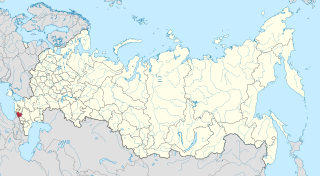
The Karachay-Cherkess Republic or Karachay-Cherkessia is a federal subject of Russia. It is geographically located in the North Caucasus region of Southern Russia and is administratively part of the North Caucasian Federal District. Karachay-Cherkessia has a population of 477,859.
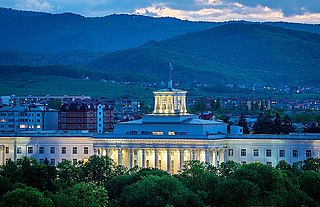
Nalchik is the capital city of the Kabardino-Balkar Republic, Russia, situated at an altitude of 550 meters (1,800 ft) in the foothills of the Caucasus Mountains; about 100 kilometers (62 mi) northwest of Beslan. It covers an area of 131 square kilometers (51 sq mi). Its population has fluctuated over the years, with the following numbers: 240,203 (2010 Census); 274,974 (2002 Census); 234,547 (1989 Census).

The North Caucasus, or Ciscaucasia, is the northern part of the Caucasus region between the Sea of Azov and Black Sea on the west and the Caspian Sea on the east, in Russia. Geographically, the Northern Caucasus includes the Russian republics and krais of the North Caucasus. As part of the Russian Federation, the Northern Caucasus region is included in the North Caucasian and Southern Federal Districts and consists of Krasnodar Krai, Stavropol Krai, and the constituent republics, approximately from west to east: the Republic of Adygea, Karachay–Cherkessia, Kabardino-Balkaria, North Ossetia–Alania, Ingushetia, Chechnya, and the Republic of Dagestan.
The Balkars are a Turkic people of the Caucasus region, one of the titular populations of Kabardino-Balkaria. Their Karachay-Balkar language is of the Ponto-Caspian subgroup of the Northwestern (Kipchak) group of Turkic languages.
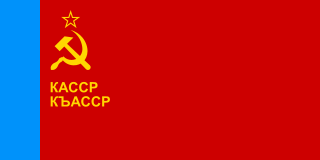
Kabardin Autonomous Soviet Socialist Republic, was the name given to Kabardino-Balkar ASSR after deportation of the Balkars in 1944. In 1957, the old name was restored.
An Autonomous Soviet Socialist Republic (ASSR) of the Union of Soviet Socialist Republics was a type of administrative unit in the Union of Soviet Socialist Republics (USSR) created for certain nations. The ASSRs had a status lower than the union republics of the USSR, but higher than the autonomous oblasts and the autonomous okrugs.

Russia is divided into twelve economic regions —groups of federal subjects sharing the following characteristics:

The Kabardino-Balkarian Republic or Kabardino-Balkaria, is a federal subject of Russia located in the North Caucasus. As of the 2010 Census, its population was 859,939 on 12,500 square km. Its capital is Nalchik. The area contains the highest mountain in Europe, Mount Elbrus, at 5,642 m. Mount Elbrus has 22 glaciers that feed three rivers — Baksan, Malka and Kuban. The mountain is covered with snow year-round.
The Republic of Kabardino-Balkaria is a federal subject of Russia, located in the Caucasus region.
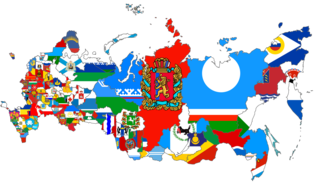
This gallery of flags of federal subjects of Russia shows the flags of the 85 federal subjects of Russia.
Autonomous oblasts of the Union of Soviet Socialist Republics were administrative units created for a number of smaller nations, which were given autonomy within the fifteen republics of the USSR.

Abazinia, Abazashta or Abaza is a historical country at the northern mountainside of the Caucasus Major, now the northern part of Karachay–Cherkessian Republic, Russia. Abazinia is a home of the Abazins, a people related to the Abkhaz people that speak the Abazin language.
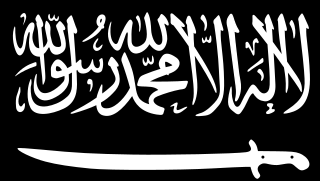
The United Vilayat of Kabarda-Balkaria-Karachai, also known as Vilayat KBK, was a militant Islamist Jihadist organization connected to numerous attacks against the local and federal security forces in the Russian republics of Kabardino-Balkaria and Karachay-Cherkessia in the North Caucasus. Vilayet KBK has been a member of the Caucasus Emirate group since 2007.
Russia has international borders with 16 sovereign states, including two with maritime boundaries, as well as with the partially recognized states of South Ossetia and Abkhazia. With a land border running 20,241 kilometres (12,577 mi) in total, Russia has, the second-longest land border of any country.

The South-East, also referred to as South-Eastern Krai and South-Eastern Oblast was a territory, and later an administrative division, of the Russian Soviet Federative Socialist Republic (RSFSR) which existed in 1920-1924.
Balkar and Karachai nationalism is the national sentiment among the Balkars and Karachai. It generally manifests itself in:

The Kabardino-Balkar Autonomous Soviet Socialist Republic was an autonomous republic of the Russian Soviet Federative Socialist Republic, in the former Soviet Union, and was originally a part of the Mountain Autonomous Soviet Socialist Republic. On 16 January 1922 the region was detached from the Mountain ASSR and the Kabardino-Balkar Autonomous Oblast on 1 September 1921. It became an autonomous republic on 5 December 1936. On 30 January 1991, the Kabardino-Balkar ASSR declared state sovereignty. It is now the Kabardino-Balkaria republic, a federal subject of the Russian Federation. The Kabardino-Balkar ASSR bordered no other sovereign states during the existence of the Soviet Union.
Asker Dzhappuyev also known as Emir Abdullah, was the leader of the Jihadist United Vilayat of Kabarda-Balkaria-Karachai organisation in the Russian Republic of Kabardino-Balkaria.
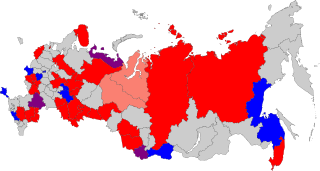
Election Day in Russia was held on September 14, 2014.












